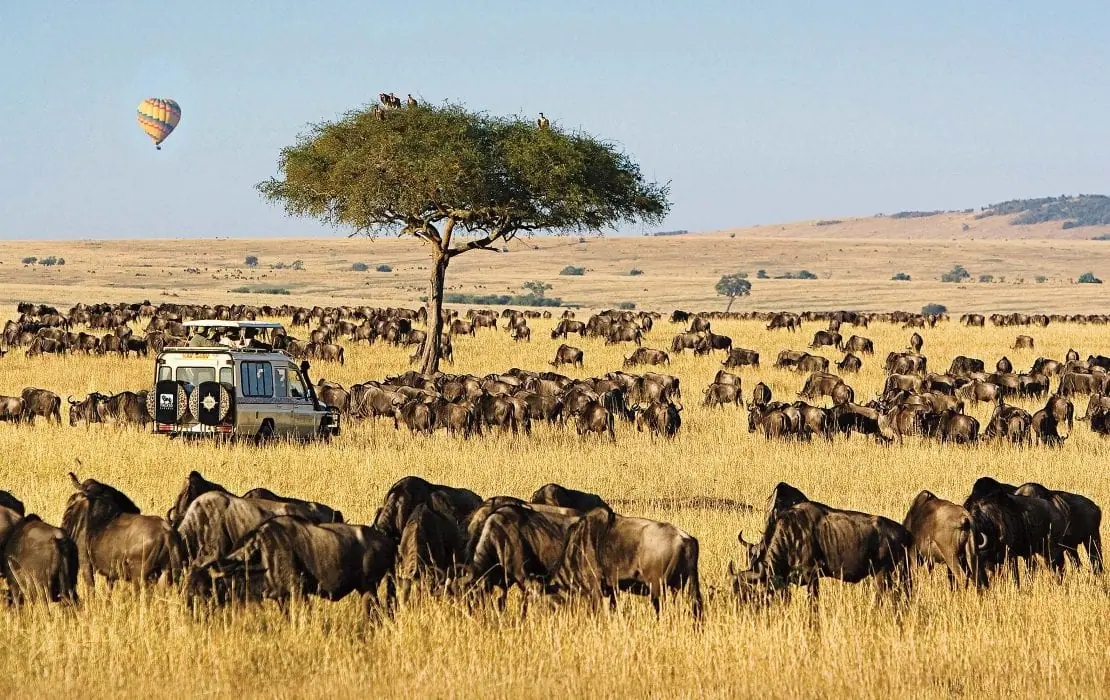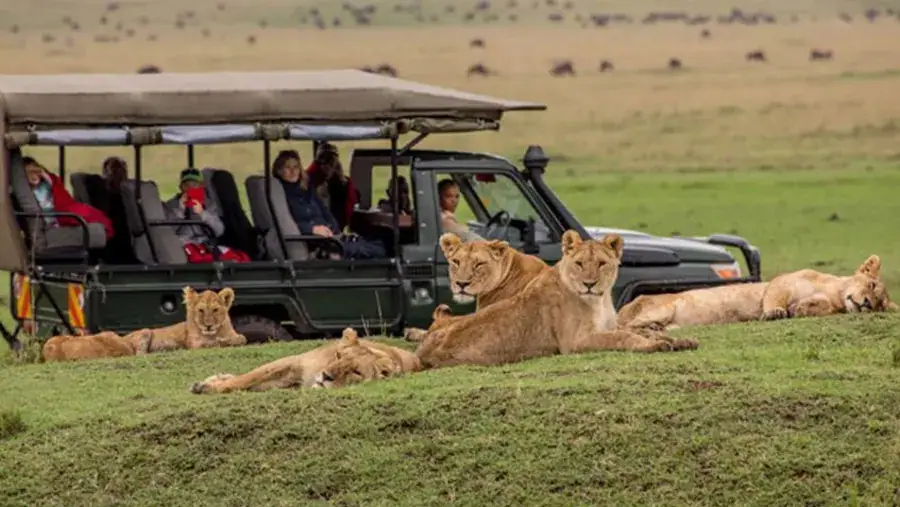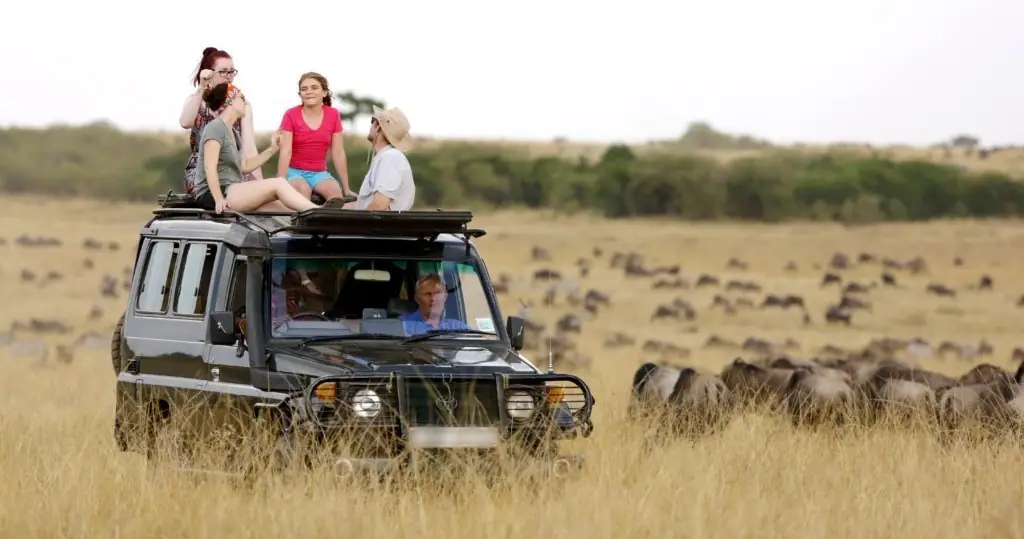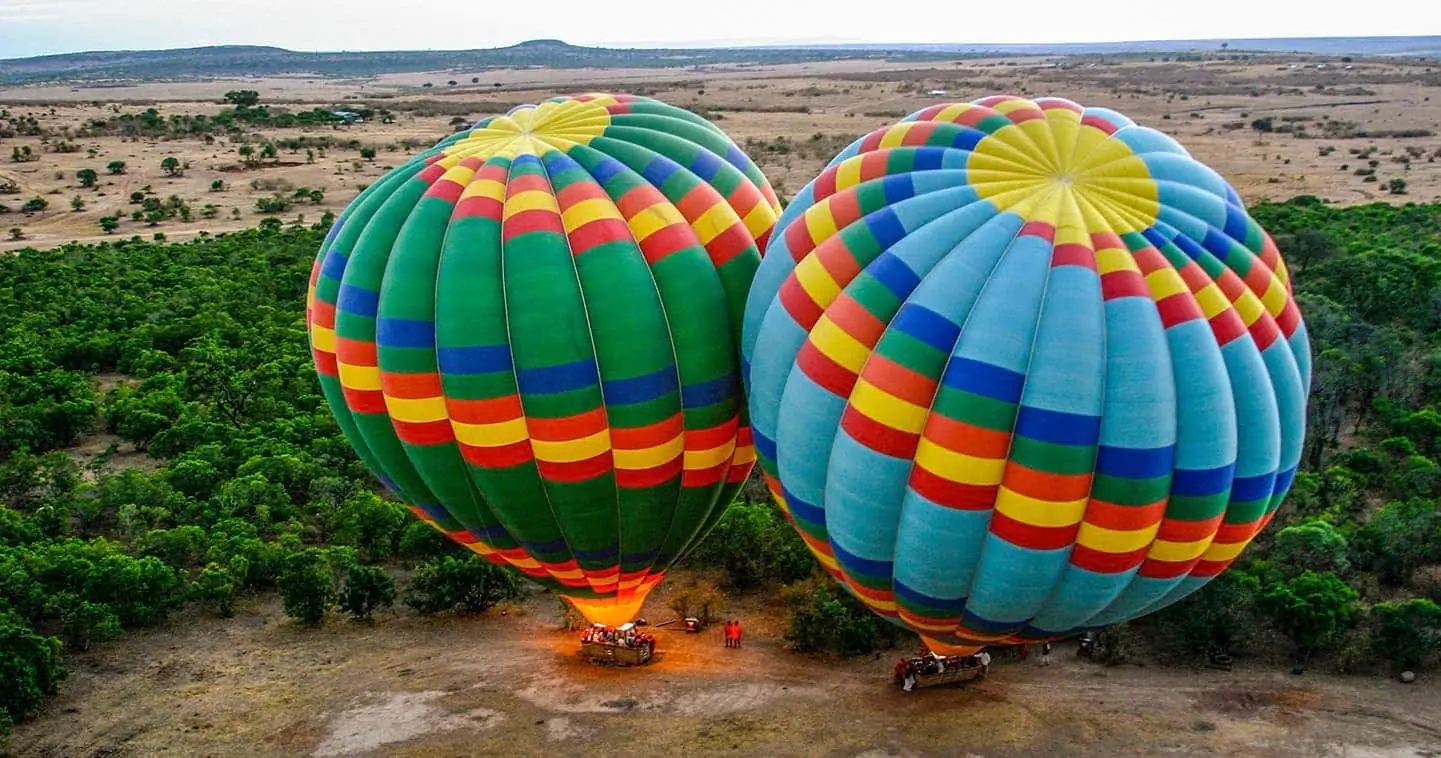Essential Guide to the Great Migration in Masai Mara: What to Expect
Table of Contents
The Great Migration is a breathtaking natural event that happens across the vast Serengeti-Masai Mara plains and the Masai Mara Reserve. This spectacle captivates travelers and wildlife enthusiasts as they witness the incredible journey of 1.5 million wildebeest and other herbivores.
Each year, over two million wildebeest, zebra, and other herbivores trek from the southern Serengeti to the lush green grasses of the Masai Mara. These animals navigate challenging terrains, facing predators and natural obstacles.
The Masai Mara National Reserve is the perfect place to see this event up close, offering a once-in-a-lifetime chance to observe nature’s grandeur. This epic journey involves over a million wildebeest herds, zebras, elands, and gazelles as they migrate from the Serengeti to the Masai Mara National Reserve in search of food and water.
Stages of the Annual Wildebeest Migration

The Great Migration is a complex journey that spans the Serengeti ecosystem in Tanzania and the Maasai Mara in Kenya. This migration is influenced by weather patterns, pasture availability, and the timing of the mating and calving seasons. The herds travel 800 kilometers clockwise in a circle through the Serengeti and Masai Mara ecosystems in search of greener pastures and water.
Over a million animals wildebeest migrate embark on this journey each year, driven primarily by the need for fresh grazing land and survival. As they move, they face deadly challenges including fatigue, diseases, and predators. The migration route takes the wildebeest through the Serengeti National Park, the Ngorongoro Conservation Area, and the Masai Mara National Reserve. By November, the herds start heading south back to the Serengeti.
Calving Season
The migration cycle begins with the calving season in the southern Serengeti plains of Tanzania. Pregnant wildebeest gather in large numbers to give birth to their young, with hundreds of thousands of calves born during this time.
The herds linger here as wobbly calves try to find their footing. This period is critical in the Great Migration, with the wildebeest giving birth to over 400,000 calves in just two to three weeks. The abundance of vulnerable young calves attracts predators, who find hunting easier during this time. The presence of predators creates a scene of frantic herds as they try to protect their young.
Migration Patterns
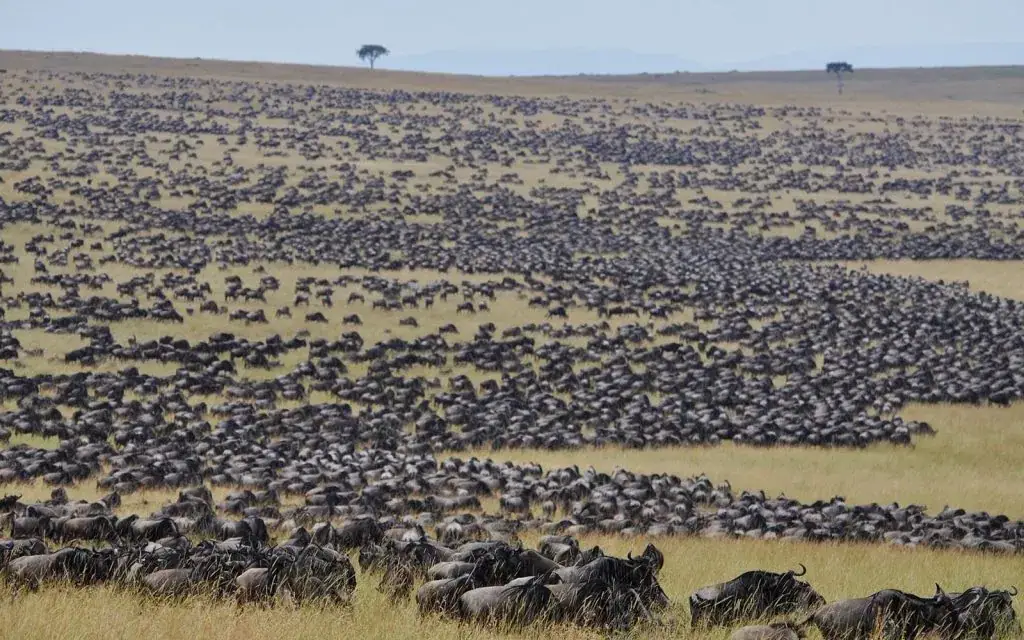
With the onset of the long rains in April and May, migratory herds begin their northward migration toward the Moru Kopjes and the Simba Kopjes. This stage is marked by vast herds stretching as far as the eye can see, accompanied by zebras, gazelles, and other herbivores. Wildebeest funnel up into central Serengeti and eastern Serengeti in search of fresh pastures.
The migration patterns are influenced by the weather, with the wildebeest following the rains and the growth of new grass. They migrate through the Western Corridor, the Northern Serengeti, and the Masai Mara National Reserve. Come October, the rains begin to fall and by November the herds start heading back to the Serengeti. By early November, the herds start their journey back to the Serengeti.
Maasai Mara National Reserve
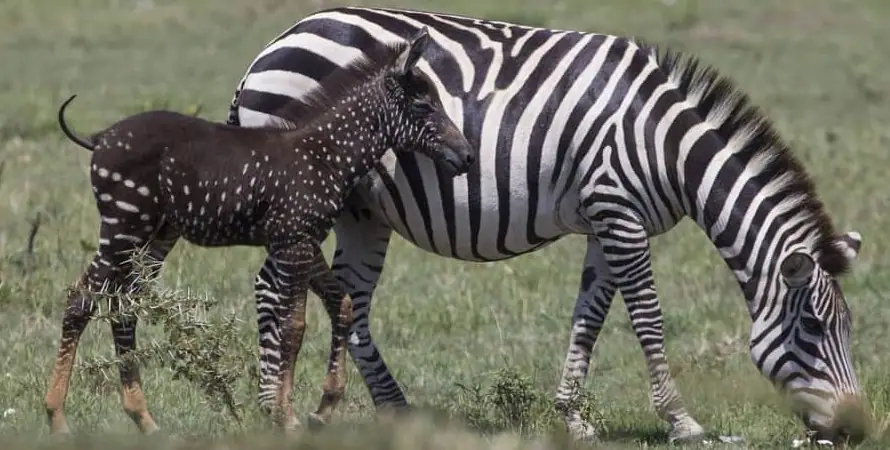
The Maasai Mara National Reserve is one of the best places to witness the Great Migration. The reserve is home to a diverse range of wildlife, including wildebeest, zebras, elands, and gazelles.
Known for its abundant wildlife, big cats, and the Big Five – lion, leopard, rhinoceros, elephant, and Cape buffalo – the Maasai Mara offers a unique opportunity to see the Great Migration, with wildebeest crossing the Mara River and the Talek River.
The animals spend several months trekking the bountiful plains of the Masai Mara. The reserve is a prime destination for safari-goers, with its vast plains and abundant wildlife. The reserve also includes private conservancies like Mara North and Olare Orok, which provide lush grazing resources for the migrating herds.
Great Migration in Masai Mara – River Crossings
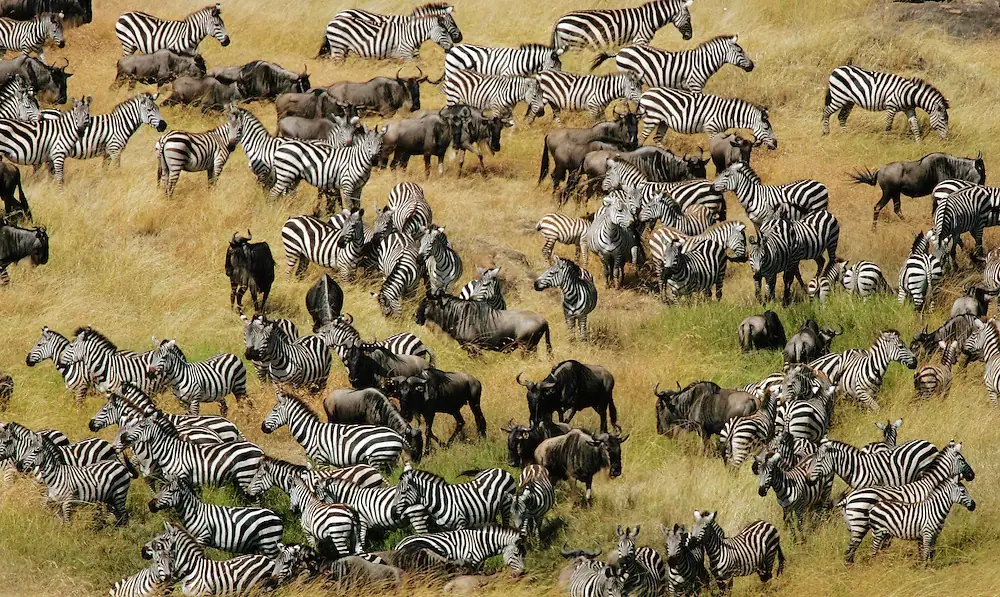
The Mara River crossing is a critical event in the Great Migration, with thousands of wildebeest, zebras, elands, and gazelles gathering on the riverbanks and attempting to cross to the opposite bank. This crossing is a high-risk event, with Nile crocodiles and other predators waiting to attack, making it a thrilling and emotional experience for spectators.
The wildebeest gather on the riverbanks, waiting for the right moment to wildebeest cross, and the energy in the air is palpable as they nervously watch the water for predators. The Mara River crossing is a testament to the resilience and determination of the wildebeest, with thousands of animals successfully crossing each year. River crossings are a key part of the Great Migration, with crossings at the Mara and Talek rivers, and the Grumeti River.
Planning a Great Migration Safari
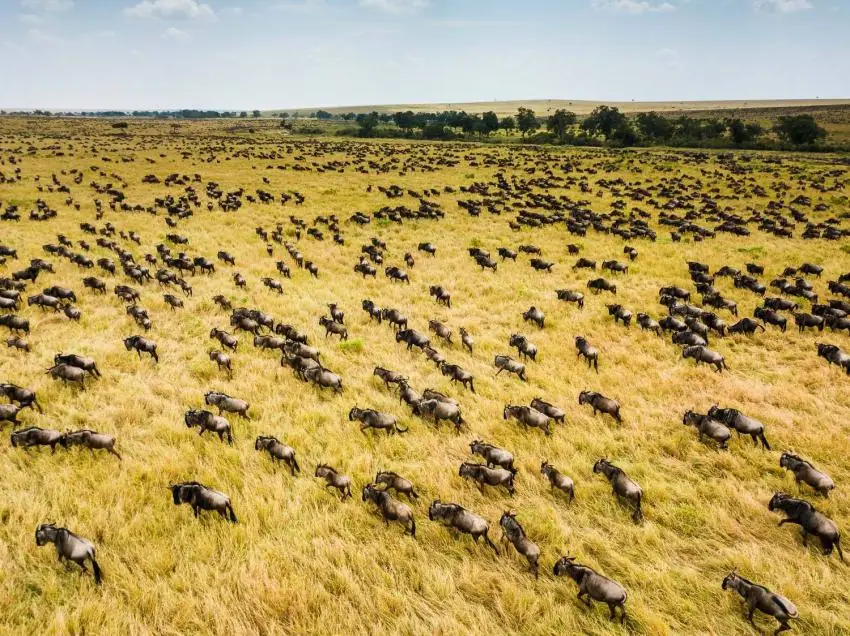
Planning a Great Migration safari requires careful consideration of the time of year, the location, and the type of accommodation. The best time for a Migration safari depends on which events you’re interested in seeing, with the peak season from July to October.
The Serengeti and Masai Mara are fantastic year-round safari destinations, with the Great Migration as a key attraction. A well-thought-out plan can elevate your experience, allowing you to appreciate this unique wildlife spectacle. It’s essential to book early, at least a year in advance, to secure lodges and camps. To maximize your experience, plan to visit Masai Mara during the peak migration season.
Timing Your 2025 Masai Mara Migration Safari
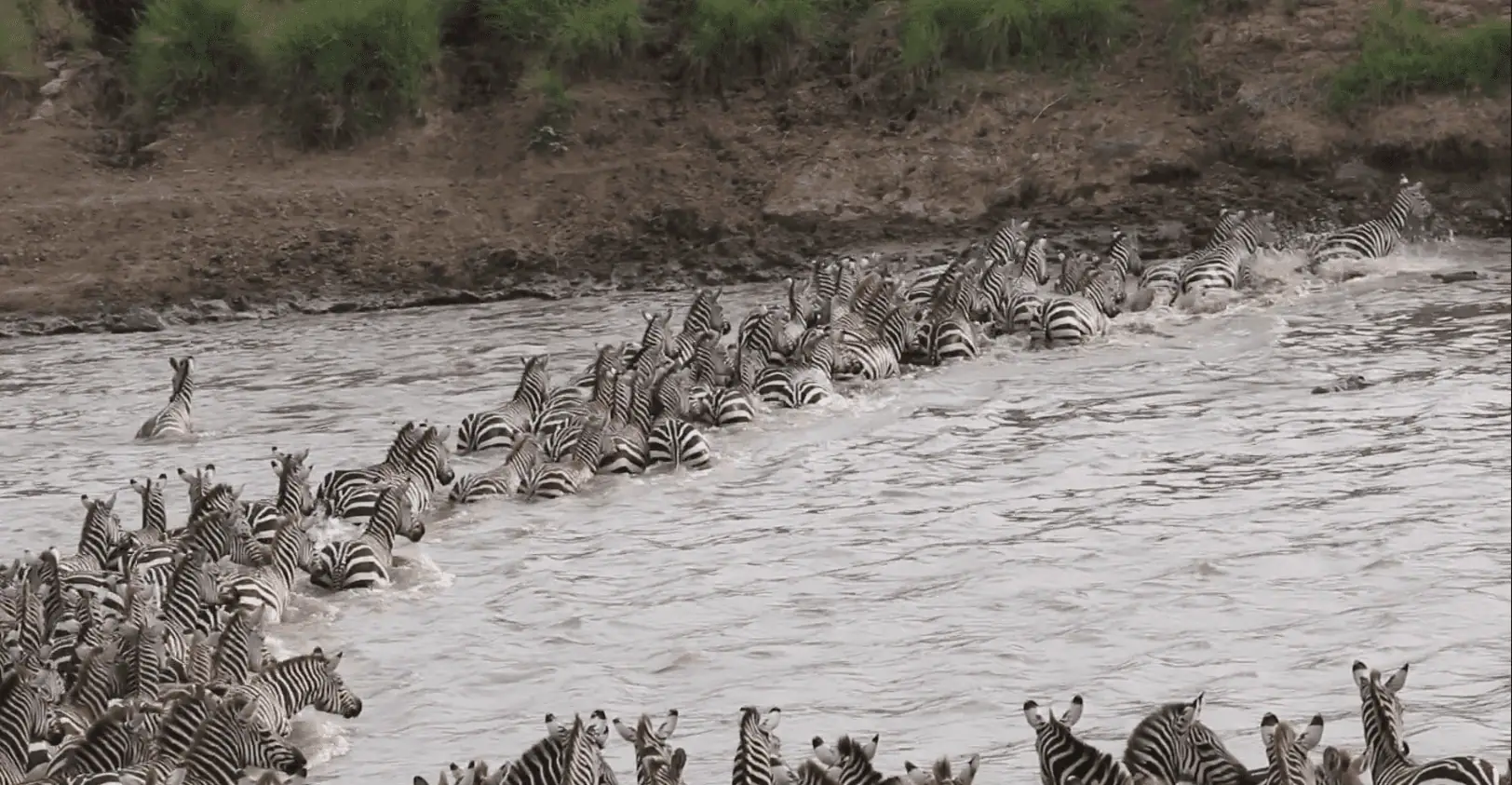
The best time to witness the Great Migration is from July to October, with the most significant Mara River crossings occurring from late July to August and sometimes extending into September. Most of the wildebeest and their migration companions will have reached the Mara by August. The migration is an ongoing event, with wildebeest traveling throughout the year in search of food and water during the rainy season.
The peak season for the Great Migration is from July to October, with river crossings being a key attraction. The timing of the safari depends on the events you want to see, such as the calving season, migration patterns, and river crossings. The Great Migration is a year-round event, with wildebeest migrating through the Serengeti and the Masai Mara National Reserve. During the rainy season, the herds move through the western Serengeti in search of fresh grazing.
Safari Accommodations
There are various types of accommodations available for a Great Migration safari, including luxury lodges, mid-range lodges, and budget-friendly options. The type of accommodation depends on your budget and preferences, with some lodges offering luxury amenities and others a more rustic experience.
Mobile camps are also an option, with some camps moving with the migration and others staying in one location. Accommodations offer a unique opportunity to experience the Great Migration, with some lodges and camps offering guided tours and others self-drive options.
Safari accommodations range from basic tents to luxury lodges, with some offering walking safaris and others game drives. Some mobile camps follow the migration through the eastern Serengeti, offering a unique and immersive experience.
Other Information About Masai Mara and Conservancy:
Welcome to AjKenya Safaris
Thanks for stopping by! We’re excited to help you plan an unforgettable safari.
- Phone: +254 748 258880
- WhatsApp: +254 748 258880
- Email: [email protected]
- Email: [email protected]

